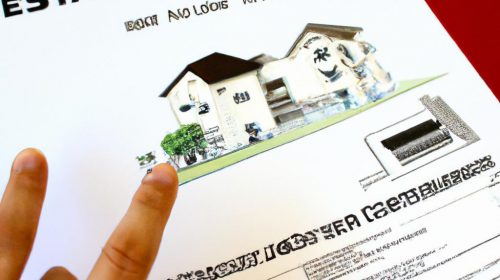Property Inspection: Real Estate Appraisal Explained
Property inspection plays a crucial role in the real estate industry, providing valuable insights into the value and condition of properties. It serves as an essential step in the process of buying or selling a property, aiding both buyers and sellers in making informed decisions. For instance, imagine a potential buyer interested in purchasing a charming Victorian-era house located in a historic neighborhood. Before finalizing the transaction, this buyer would want to ensure that the property is accurately appraised to determine its market value and identify any potential issues.
Real estate appraisal forms an integral part of property inspection, providing an objective assessment of a property’s worth based on various factors such as location, size, amenities, and overall condition. Appraisals are conducted by licensed professionals who possess expertise in evaluating real estate values. By employing standardized methods and techniques, these experts analyze comparable sales data, inspect the property thoroughly, and consider relevant factors influencing its value. The aim is to provide an unbiased opinion regarding the fair market value of the property at hand.
In this article, we will delve deeper into the intricacies of property inspection and explore how real estate appraisal works. We will discuss the importance of accurate valuations for both buyers and sellers, highlighting key elements involved in assessing a property’s worth. Additionally, Additionally, we will explain the different approaches used in real estate appraisal, such as the cost approach, sales comparison approach, and income approach. These methods take into account factors such as the property’s construction quality, recent sales of comparable properties in the area, and potential rental income. By considering these various factors, appraisers can provide a comprehensive evaluation that reflects the true value of the property.
Furthermore, we will discuss how property inspections go beyond just determining market value. Inspectors also assess the condition of a property to identify any potential issues or defects that may affect its value or pose safety concerns. This includes examining the foundation, roof, plumbing systems, electrical systems, and overall structural integrity.
We will also touch upon the role of technology in property inspection and appraisal processes. Nowadays, advancements such as aerial imaging drones and virtual reality walkthroughs allow for more accurate assessments and efficient data collection.
Lastly, we will outline some tips for buyers and sellers to consider when it comes to property inspections and appraisals. Whether you are buying or selling a property, being informed about the process can help you make better decisions and negotiate effectively.
Overall, this article aims to provide a comprehensive understanding of property inspection and real estate appraisal. Whether you are a buyer or seller in the real estate market, having knowledge about these processes is crucial for making informed decisions and ensuring fair transactions.
What is a property inspection?
What is a property inspection?
A property inspection is an essential step in the process of buying or selling real estate. It involves a comprehensive assessment and evaluation of a property’s condition, functionality, and overall value. By conducting a thorough examination, certified inspectors can identify any potential issues that may affect the property’s desirability or market price.
To illustrate this further, let’s consider a hypothetical scenario: John is interested in purchasing his first home. Before making such a significant financial commitment, he decides to hire a professional inspector to conduct a property inspection. During the inspection, the inspector thoroughly examines various aspects of the house, including its structure, electrical systems, plumbing, heating and cooling systems, as well as other features like roofing and insulation.
The importance of property inspections cannot be overstated. Here are some key reasons why they are crucial:
- Peace of mind: A property inspection provides buyers with confidence and peace of mind by ensuring that they have accurate information about the condition of the property before making their purchase decision.
- Negotiation power: Armed with knowledge from the inspection report, buyers can negotiate better terms with sellers if there are any identified issues that need addressing.
- Preventive maintenance: Property inspections can help homeowners identify potential problems early on so that necessary repairs or maintenance tasks can be carried out promptly, preventing more extensive damage in the future.
- Protection for lenders: Lenders often require property inspections to ensure that their investment is protected against any hidden hazards or risks associated with the property.
| Aspect | Importance | Benefit |
|---|---|---|
| Peace of Mind | Provides assurance | Reduces anxiety |
| Negotiation Power | Better deal | Saves money |
| Preventive Maintenance | Early problem detection | Avoids costly repairs |
| Protection for Lenders | Risk mitigation | Protects investments |
In light of these factors, property inspections play a crucial role in the real estate industry. They provide valuable insights and information to buyers, sellers, lenders, and homeowners alike. In the subsequent section, we will explore why property inspection is important in greater detail.
Why is property inspection important?
Property Inspection: Real Estate Appraisal Explained
Having understood the concept of property inspection, let us now explore why it holds significant importance in the real estate industry. To better illustrate this, consider a hypothetical scenario where a potential buyer is interested in purchasing a house listed on the market. Before making an offer, they decide to conduct a thorough property inspection to assess its condition and value.
Firstly, property inspections provide buyers with valuable information about the physical condition of the property. Through a comprehensive examination of various aspects such as structural integrity, plumbing systems, electrical systems, and more, inspectors can identify any existing or potential issues. This knowledge empowers buyers to make informed decisions regarding their investment and negotiate prices accordingly.
Secondly, property inspections serve as a risk management tool for both buyers and sellers. By uncovering underlying problems or safety hazards that may not be immediately apparent during initial viewings, inspections help mitigate future complications or unexpected costs associated with repairs or renovations. Moreover, sellers can benefit from conducting pre-listing inspections as they demonstrate transparency and instill confidence in potential buyers.
Finally, property inspections contribute to establishing fair market values for properties. When assessing a property’s worth, appraisers take into account factors such as location, size, amenities, and overall condition. The findings from an inspection directly influence these evaluations by providing objective evidence of a property’s current state. Consequently, accurate appraisals ensure fair transactions between parties involved while reducing risks associated with overpaying or undervaluing properties.
To further emphasize the significance of property inspections in real estate transactions:
- They protect buyers from investing in properties with hidden defects.
- They allow sellers to showcase their homes’ condition transparently.
- They aid in determining appropriate pricing based on actual conditions.
- They minimize post-purchase surprises and unforeseen expenses.
Consider the following table highlighting some common issues discovered during property inspections:
| Issue | Impact | Solution |
|---|---|---|
| Roof leaks | Potential water damage | Repair or replacement |
| Faulty electrical wiring | Fire hazards | Rewiring or repairs |
| Mold infestation | Health risks, structural concerns | Remediation and prevention measures |
| Foundation cracks | Structural instability, moisture | Repairs or foundation reinforcement |
By addressing these issues promptly, buyers can make informed decisions while sellers can ensure a smooth transaction process. With the understanding of why property inspections are important established, let us now delve into who conducts these inspections and their qualifications.
Who conducts property inspections?
Property Inspection: Real Estate Appraisal Explained
Why is property inspection important? Let’s delve deeper into understanding who conducts these inspections and what factors are considered during the process.
To illustrate the significance of property inspections, let’s consider an example. Imagine an individual named John who wants to purchase a house. Prior to making such a substantial investment, it is essential for John to have a comprehensive understanding of the condition and value of the property he intends to buy. This is where property inspections come into play.
During a property inspection, professionals known as appraisers or inspectors assess various aspects related to the condition and worthiness of a property. These experts evaluate both the interior and exterior features, including structural elements, electrical systems, plumbing fixtures, heating and cooling systems, insulation levels, roofing materials, and more. By conducting meticulous examinations and documenting their findings, appraisers provide invaluable insights that help buyers like John make informed decisions regarding their potential investments.
Consider the following emotional response-inducing bullet point list on why property inspections matter:
- Ensures safety and identifies potential hazards.
- Provides peace of mind by uncovering hidden issues.
- Helps negotiate fair prices based on accurate assessments.
- Protects buyers from investing in properties with major defects.
In addition to detailed reports provided by appraisers after completing inspections, they often utilize tables to present key information concisely. Here’s an example three-column table highlighting different areas evaluated during a typical home inspection:
| Area Assessed | Examples | Potential Issues |
|---|---|---|
| Structure | Foundation settling | Cracks in walls or floors |
| Electrical Systems | Wiring condition | Faulty outlets |
| Plumbing Fixtures | Leaks | Poor water pressure |
| Heating/Cooling | Functionality of HVAC systems | Inadequate temperature control |
By examining these various aspects, property inspections serve as a vital tool in providing potential buyers with an accurate assessment of the condition and value of real estate properties.
In the subsequent section, we will explore the key components involved in conducting a thorough property inspection. Understanding these elements will further enhance our comprehension of this intricate process, enabling us to make more informed decisions when engaging in real estate transactions.
What are the key components of a property inspection?
Property inspections play a crucial role in the real estate appraisal process as they provide an objective evaluation of a property’s condition and value. Conducted by certified professionals, these inspections ensure that potential buyers or lenders have accurate information about the property before making any decisions. To better understand how property inspections contribute to real estate appraisals, let’s explore the key components involved.
One example of a property inspection might involve a house located in a suburban neighborhood. The inspector would examine both the interior and exterior aspects of the property, assessing its overall condition, functionality, and safety. This includes inspecting the foundation, roof, electrical system, plumbing, HVAC (heating, ventilation, and air conditioning) system, insulation, windows, doors, and other structural elements.
During a property inspection, various factors are taken into consideration to determine the value of the property accurately. These include:
- Age and condition: The age of the structure and its overall condition significantly impact its value.
- Upgrades and renovations: Recent upgrades or renovations can increase a property’s value.
- Market trends: Current market conditions play a vital role in determining property values.
- Location: The location of the property affects its desirability and subsequent value.
To visually represent some common findings during property inspections that could affect valuation positively or negatively, consider this table:
| Finding | Impact on Valuation |
|---|---|
| Cracks in foundation | Negative |
| Updated kitchen | Positive |
| Roof leaks | Negative |
| Energy-efficient HVAC system | Positive |
In summary, property inspections are conducted by certified professionals to evaluate a variety of factors that influence a property’s value. Through thorough examination of both internal and external components, inspectors help potential buyers make informed decisions while ensuring lenders assess risks accurately. By considering aspects such as age, condition, upgrades/renovations made to the structure along with current market trends and location, property inspections play a pivotal role in real estate appraisals.
Understanding the key components of a property inspection provides us with valuable insights into how property values are determined during this process. So, let’s delve deeper into how professionals evaluate these factors to arrive at an accurate appraisal.
How is property value determined during an inspection?
In order to accurately appraise a property, a thorough inspection is conducted. This section will outline the key components of a property inspection as well as how value is determined during this process.
To better understand the importance of a property inspection, consider the following example: A potential buyer named Sarah is interested in purchasing a house located in a suburban neighborhood. She hires an experienced real estate appraiser who conducts a detailed examination of the property’s features and condition.
During a property inspection, several factors are assessed to determine its overall value:
- Structural Integrity: The foundation, walls, roof, and other structural elements are thoroughly inspected for any signs of damage or deterioration.
- Interior Condition: The quality and condition of various interior components such as flooring, paintwork, fixtures, appliances, plumbing systems, electrical wiring, etc., are evaluated.
- Exterior Features: The exterior aspects including landscaping, driveways, fences, decks/patios, swimming pools (if applicable), and general curb appeal are considered.
- Comparable Properties: An analysis is carried out on similar properties recently sold in the area to compare their features and prices with the subject property being appraised.
The table below illustrates how these factors can impact the appraisal value:
| Factor | Impact on Appraisal Value |
|---|---|
| Excellent Structural Integrity | Higher Value |
| Well-Maintained Interior Condition | Higher Value |
| Attractive Exterior Features | Higher Value |
| Comparable Sales Prices | Influences Market Value |
It should be noted that each factor carries different weightage depending on location and market conditions; moreover, additional considerations may also come into play based on specific requirements set by lenders or regulatory bodies.
Understanding the critical components involved in determining property value allows both buyers and sellers to make informed decisions regarding pricing strategies. With this knowledge at hand, let’s now explore the different types of property inspections.
[Transition] Moving forward, we will delve into the various types of property inspections and how they cater to specific needs.
What are the different types of property inspections?
Property Inspection: Real Estate Appraisal Explained
During a property inspection, the determination of its value involves a comprehensive assessment by a professional appraiser. This appraisal process considers various factors that contribute to the property’s worth. For instance, let’s consider a hypothetical case study of a residential house located in a suburban neighborhood.
Firstly, the appraiser would evaluate the location and surroundings of the property. Factors such as proximity to schools, hospitals, shopping centers, and transportation links are taken into account. Additionally, they might also look at local market trends and analyze recent sales data of comparable properties in the area.
Secondly, the physical condition of the house itself plays a significant role in determining its value. The appraiser will inspect both the interior and exterior elements including structural integrity, quality of construction materials used, overall maintenance level, any visible damages or repairs required, and functional systems like plumbing and electrical.
Lastly, various amenities and features provided by the property are considered. These may include aspects such as landscaping design, swimming pool presence or absence, garage capacity, number of bedrooms and bathrooms available, additional rooms (like an office or gym), energy-efficient appliances installed if any – all these factors can influence the final valuation.
To further illustrate this point with emotional appeal:
Factors affecting property value during an inspection:
- Curb appeal: A well-maintained lawn with attractive landscaping can create positive emotions for potential buyers.
- Renovations/upgrades: Modernized kitchens or bathrooms can generate excitement about living in a contemporary space.
- Neighborhood safety: A secure environment where families feel protected from crime can evoke peace of mind.
- Natural lighting: Ample sunlight filtering through large windows creates feelings of warmth and spaciousness.
Table highlighting different factors influencing property valuation:
| Factor | Emotional Impact |
|---|---|
| Curb Appeal | Positive |
| Renovations | Excitement |
| Neighborhood | Security |
| Natural Lighting | Warmth |
In summary, property value during an inspection is determined by evaluating the location, physical condition of the property itself, and various amenities it offers. It involves considering factors that can evoke emotional responses from potential buyers such as curb appeal, renovations/upgrades, neighborhood safety, and natural lighting. By assessing these aspects comprehensively, appraisers provide a fair valuation that helps both sellers and buyers make informed decisions in the real estate market.



